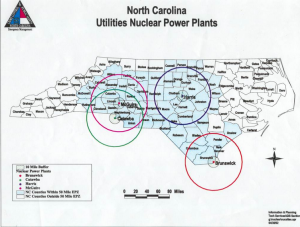Are you within 10 miles of a nuclear power plant?
The Nuclear Regulatory Commission (NRC) mandates that cities have an emergency evacuation plan for a 10-mile zone around a nuclear power plant – the ERZ or Emergency Planning Zone. The rationale is that a radiation plume could impact people within this zone, so the plan is to remove people from the area as quickly as possible.
Outside the 10 mile zone, the NRC identifies a second zone that stretches out to 50 miles. Within this 50-mile zone, people won’t necessarily be directly affected, but food and water may become contaminated, so the plan needs to consider these dangers.

Example of multiple and overlapping EPZs
The graphic shows examples of multiple and even overlapping EPZs in North Carolina.
Recent news reports suggest that the EPZ rules from the NRC may be woefully inadequate.
Here are questions you (and your neighborhood CERT group) should get the answers to.
If you live within 10 miles of a nuclear plant, ask . . .
“What’s my city’s plan for me?”
Get a hold of your City’s Office of Emergency Services and pose questions like these:
- What are the evacuation routes out of the zone?
- Are they the same in summer and winter, when they may be impacted by snow, high water, etc.? Day and night? Weekday and weekend?
- What year was the plan drawn up? What changes have occurred in population and in transportation options since the plan was drawn?
A 2012 study commissioned by PSEG (Public Services Energy Group) estimated that only half the population in the surveyed area (Pennsylvania, Delaware, New Jersey) could escape the 10-mile zone within 90 minutes – and the plan was based on population figures that have already been exceeded!
“What do I need to know for my family?”
Keep asking more questions. The NRC requires that cities provide residents every year with “radiological emergency planning materials.” According to FEMA, you may get this information in your utility bills, via a pamphlet, or even in the phone book. (Who reads the phone book anymore?!)
You should get answers to . . .
- How will I know there’s an emergency?
- What does radiation do, how does it act?
- What should I bring with me if we have to evacuate?
- What do I need in order to shelter in place?
- I’m disabled. How do I get special assistance? (Typically, you’ll be asked to have a written request on file.)
If you live within 50 miles of a plant, ask . . .
“Does my city have any plans for me?”
Maryland-based Disaster Accountability Project surveyed parts of 11 states within 50 miles of five operating nuclear plants, again in the northeast.
Ben Smilowitz, Executive Director of the DAP group, reported that cities are not planning beyond the 10-mile limit. Per Smilowitz, “Most people that live 20, 30, or 40 miles away from plants do not realize that their communities are only adhering to bare minimum standards for radiological emergency preparedness.”
Moreover, in this part of the country, millions of residents live within multiple overlapping emergency zones of up to seven reactors!
Find out more about nuclear reactor emergency response.
In Fukishima, the U.S. government extended the recommended EPZ to 50 miles. With this disaster still in mind, here are more resources for you and your CERT group:
- Recent Emergency Plan Guide Advisory, with suggested radiation supplies: What threat do you face from a nuclear reactor emergency?
- NRC website: How to Prepare for a Radiological Emergency http://www.nrc.gov/about-nrc/emerg-preparedness/prepare-for-radiological-emerg.html
- News article on Disaster Accountability Project: NRC Defends Current Nuclear Plant Evacuation Rules http://www.delawareonline.com/story/news/local/2015/04/17/nuclear-evacuation-study/25942751/
Virginia
Your Emergency Plan Guide Team
Don’t miss a single Advisory. You never know when you’ll need this information! Sign up below to get Advisories every week. Free.
